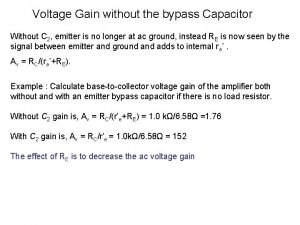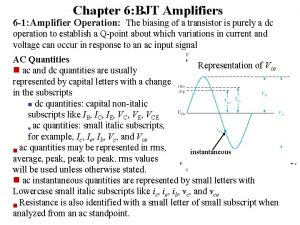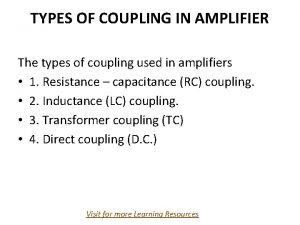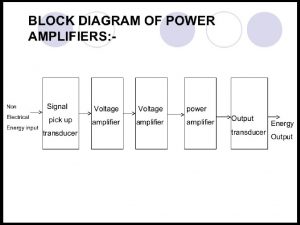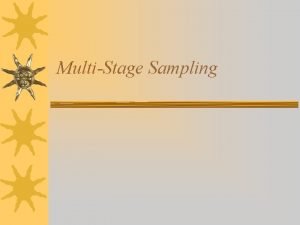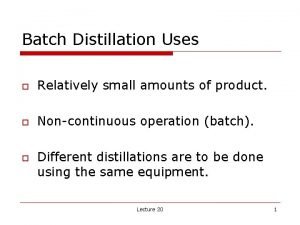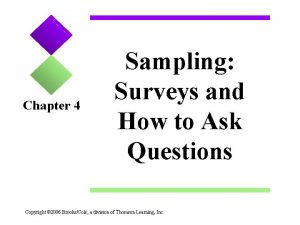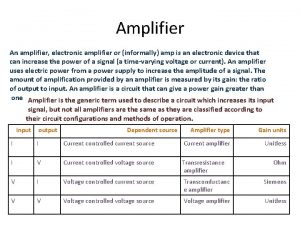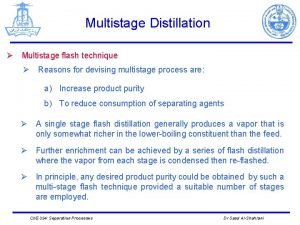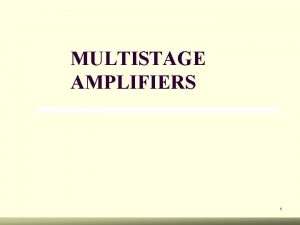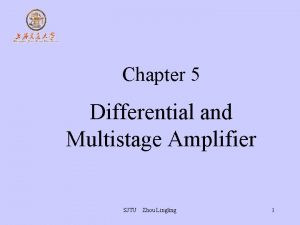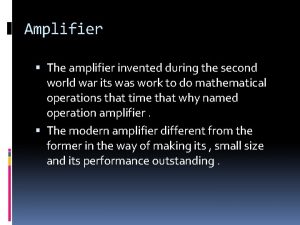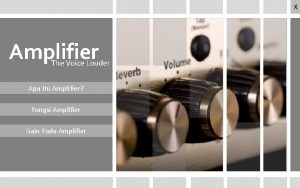MULTISTAGE AMPLIFIER Week 1 Tuesday 13 th July











- Slides: 11

MULTISTAGE AMPLIFIER Ø Week 1 Ø Tuesday (13 th July 2010) Ø BKN 4 1

MULTISTAGE AMPLIFIER Ø Many applications cannot be handled with singletransistor amplifiers in order to meet the specification of a given amplification factor, input resistance and output resistance. Ø For example, the required voltage gain may exceed that which can be obtained in a single-transistor amplifier circuit. Some particular design required low output resistance. Ø As a solution – transistor amplifier circuits can be connected in series or cascaded amplifiers. Ø This can be done either to increase the overall smallsignal voltage gain or provide an overall voltage gain greater than 1 with a very low output resistance 2

MULTISTAGE AMPLIFIER Ø Two or more amplifiers can be connected in a cascaded arrangement with the output of one amplifier driving the input of the next. Ø Each amplifier in a cascaded arrangement is known as a stage. Ø The basic purpose is to increase the overall voltage gain. 3

MULTISTAGE AMPLIFIER Multistage Voltage Gain Ø The overall voltage gain of cascaded amplifiers is the product of individual voltage gains. Ø Gain expressed in decibels (d. B) is Ø In multistage system, the overall voltage gain in d. B is the sum of individual gain 4

MULTISTAGE AMPLIFIER 5

MULTISTAGE AMPLIFIER Ø Given in previous slide is Capacitively-Coupled Multistage Amplifier. Ø Both stage are identical CE amplifier. Ø Capacitively coupling prevents dc bias of one stage affecting the other but allows ac signal to pass. Voltage Gain of the First Stage Ø Given Av = RC/r’e where RC is ac collector resistance and r’e is ac emitter resistance. Ø For the first stage, 6

MULTISTAGE AMPLIFIER Ø IE = 1. 05 m. A, r’e = 23. 8 Ω and Rin(base 2) = 3. 57 k Ω Verify all this! Ø So, the ac collector resistance for the first stage will be, Rc 1 = 4. 7 k Ω||47 k Ω||10 k Ω||3. 57 k Ω = 1. 63 k Ω Ø Thus, the gain of the first stage is 7

MULTISTAGE AMPLIFIER Ø Voltage gain of the Second Stage Ø Overall Voltage Gain 8

MULTISTAGE AMPLIFIER Ø Direct-Couple Multistage Amplifier 9

MULTISTAGE AMPLIFIER Ø No coupling or bypass capacitor. Ø Better low-frequency response than capacitively coupled type. Ø Used to amplify from low frequencies to dc (0 Hz). Ø No loss of voltage gain because no capacitive reactances in the circuit. Ø Disadvantage, small changes in dc bias voltage are amplified by succeeding stages. 10

MULTISTAGE AMPLIFIER Ø Exercise : obtain the gain for the circuit given below 11
 Advantages of multistage amplifier
Advantages of multistage amplifier Bypass av
Bypass av Conclusion operational amplifier
Conclusion operational amplifier Amplifier gain
Amplifier gain Types of coupling in multistage amplifier
Types of coupling in multistage amplifier Last week tuesday
Last week tuesday Compare voltage amplifier and power amplifier
Compare voltage amplifier and power amplifier Week by week plans for documenting children's development
Week by week plans for documenting children's development Multistage sampling
Multistage sampling Differential and multistage amplifiers
Differential and multistage amplifiers Multistage batch distillation
Multistage batch distillation Multistage sampling example
Multistage sampling example

